For many of us “shooting enthusiasts” we are the go-to person in our respective social circles for advice about anything self-defense and gun related. One of the most common questions we’re likely to be asked will be about guns for home-defense. Even if the person asking is a long-time gun owner or hunter, if they haven’t put a lot of serious thought and research into the issue of home-defense in particular, it can be hard to know where to start. Ideally, with your help, they’ll buy a quality firearm whether it’s a pistol, rifle, or shotgun, they’ll seek out some quality training classes, and practice regularly.
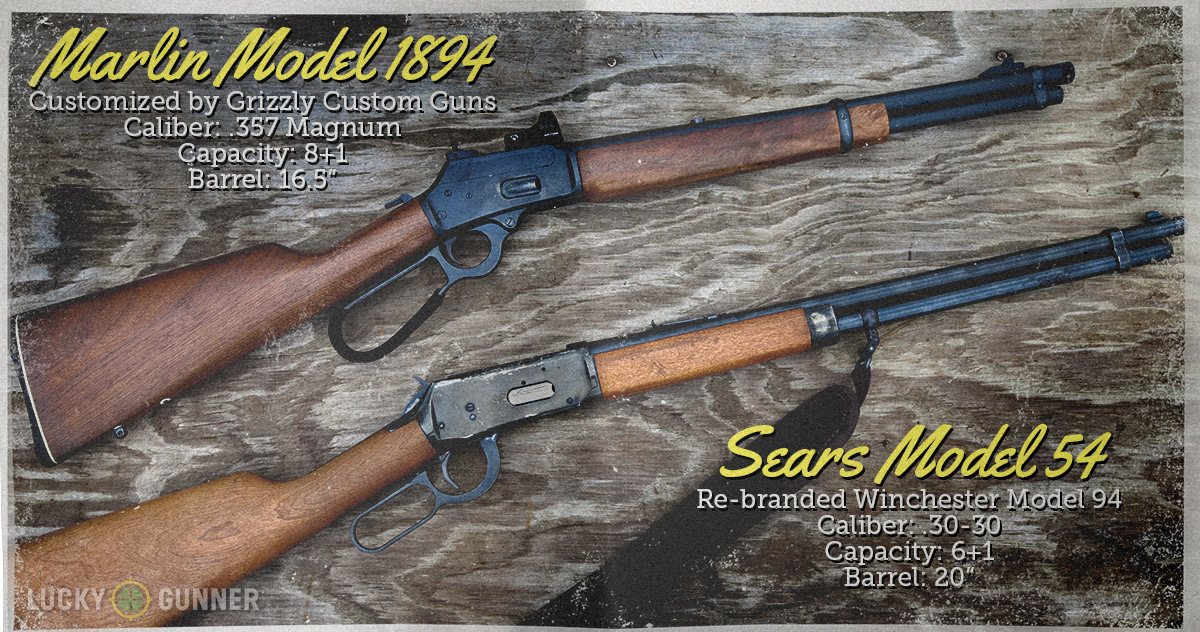
Unfortunately, it doesn’t usually work out that way, and for many people, the main limiting factor is money. The person asking for your help might only have a couple hundred bucks to spend on beefing up their self-defense gear. So instead of pointing them toward something they can’t possibly afford, is it possible to help them work with what might already own? A lot of folks have old firearms that they’ve inherited or have been given to them as gifts; double barrel shotguns, vintage military sidearms, tube-fed .22 rifles.
We may not think of these as home-defense guns, but are they better than whatever alternative their owners can afford on a tight budget?
Lever Action Rifles for Self-Defense
Let’s take a look at centerfire lever action rifles in particular. The .30-30 lever gun was once the most common deer rifle in the country, and when hunters began to gravitate toward more modern rifles, these once-beloved “brush guns” were often forgotten. But these as well as aging lever guns in many other calibers are still around, and the vast majority of them are still in good working order. If that’s all that someone happens to have, maybe it’s not such a bad option for a home-defense rifle.
I’ve had plenty of trigger time with lever actions in the past, but I’ve never run one like my life depended on it. So I took a couple of lever guns to the range to see what issues I might run into if I treated them like serious self-defense tools. The first gun was my own Marlin Model 1894 in .357 magnum — one of my favorites. It’s been customized by a gunsmith and topped off with a Burris Fastfire II reflex sight to make it the perfect tool for blowing up cans.
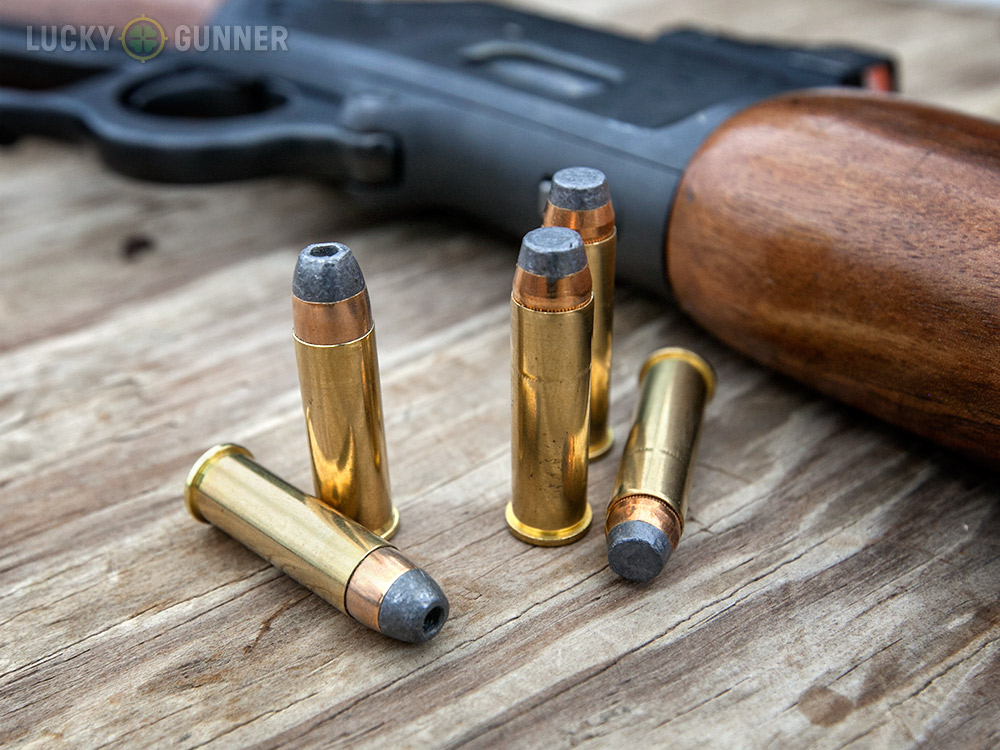
This isn’t exactly indicative of the typical lever gun someone is likely to have sitting in their closet, so I also borrowed my friend’s Sears Model 54. Winchester made these guns for Sears based on their own classic Model 94. The two are almost identical, with the wooden stock, finish, and some of the parts being of slightly lesser quality on the Sears version. This particular Model 54 was given to its current owner by another friend in exchange for helping him move. That should give you some idea of how much its previous owner valued it, which can be confirmed by the sorry state of the finish. But the old Sears rifle is in mechanically sound shape, there’s no rust or pitting to be seen, and the bore is clean.
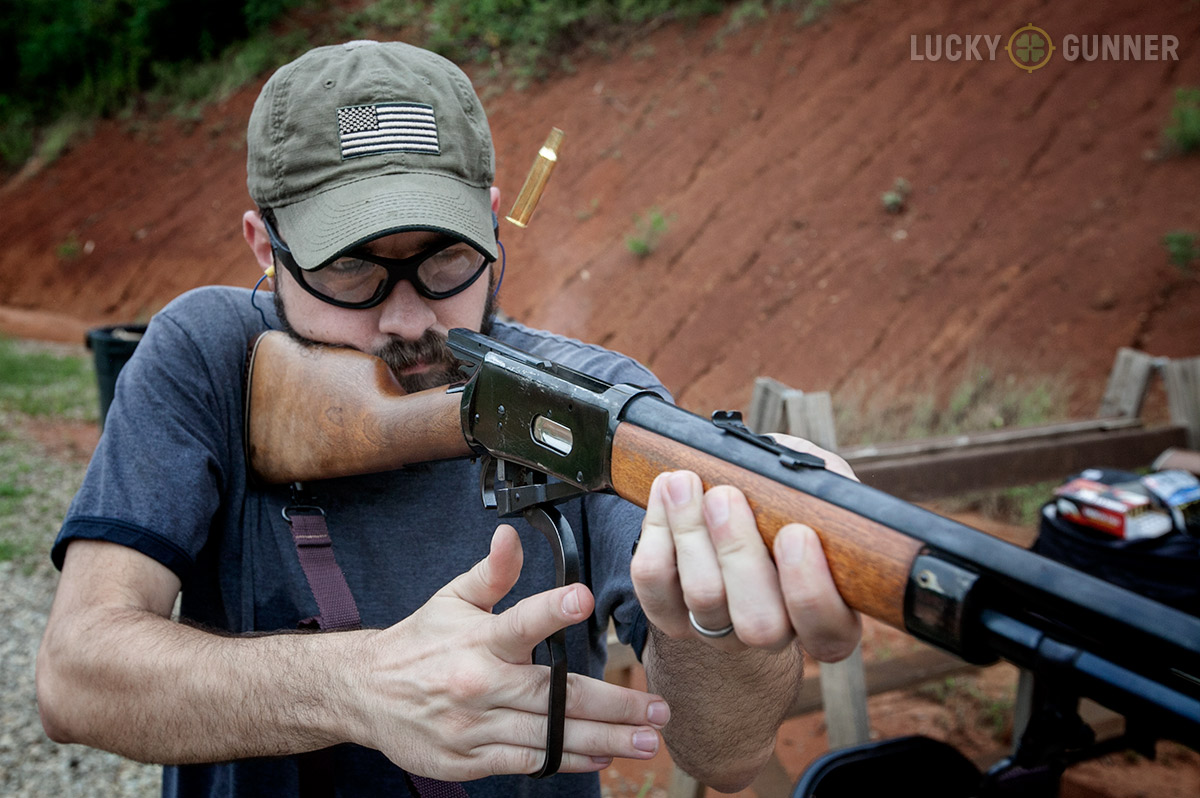
Compared to today’s magazine-fed semi-automatic rifles, lever actions are completely outclassed as home defense tools. But if you’ve ever seen a cowboy action shooter at work, then you know lever actions can still be pretty fast. As far as capacity, most magazine tubes will hold at least as many rounds, if not more, than a revolver or shotgun. The Model 54, as well as most other 20-inch barreled .30-30 riles has a 6+1 capacity. With its original 18.5-inch barrel, the Marlin 1894 could fit 9 rounds of .357 or .38 special in its tube, but my modified rifle with a cut-down barrel and mag tube has an 8-shot capacity.
Similar capacity can be found in .44 magnum and .45 Colt carbines, two of the other most common calibers for lever actions. Marlin and Winchester are possibly the most well-known lever action brands, but rifles from Rossi, Henry, Mossberg, Ruger and others are plentiful in the same calibers with similar designs and features.
Hand-me-downs seem to most often come in the revolver calibers and the classic .30-30, but there are a plethora of other calibers out there, including some “big bores” like .444 Marlin and .45-70, as well as some obscure cartridges that may have limited ammo availability today. The stiff recoil and high ammo prices for some of these larger calibers might be a deal-breaker in terms of getting in good practice time with some of these — a must for any home-defense rifle. If those factors are too much of a deterrent, they can certainly get the job done for personal protection in the home (just don’t count on hearing anything for a long, long time after setting one off indoors).
On the Range
Starting with the .357, I ran a few drills at “home defense distances” of 3-10 yards. With the Marlin, I immediately started having issues with the action binding when I tried to work the lever as rapidly as possible. I tried it with both .38 special and .357 magnum ammo, and the issue was much more pronounced with the .38s. This was the result of short-stroking the action — failure to push the lever completely forward before bringing it back. After slightly tweaking my technique, I was able to operate the gun quickly without feeding problems, and the negligible recoil of the pistol caliber rounds in the carbine made it easy to keep the reflex sight on target. At the distances I was working, I think the stock open sights would have been equally as fast, but the illuminated red dot would be missed in low light.
I think even a very green shooter could get used to shooting one of these light recoiling carbines very quickly, but it will take some dry fire repetitions with snap caps to figure out a good technique for reliably operating the lever. Extra care should also be taken to experiment with the snap caps and learn how to recover from short-stroking the action, or other feeding problems.
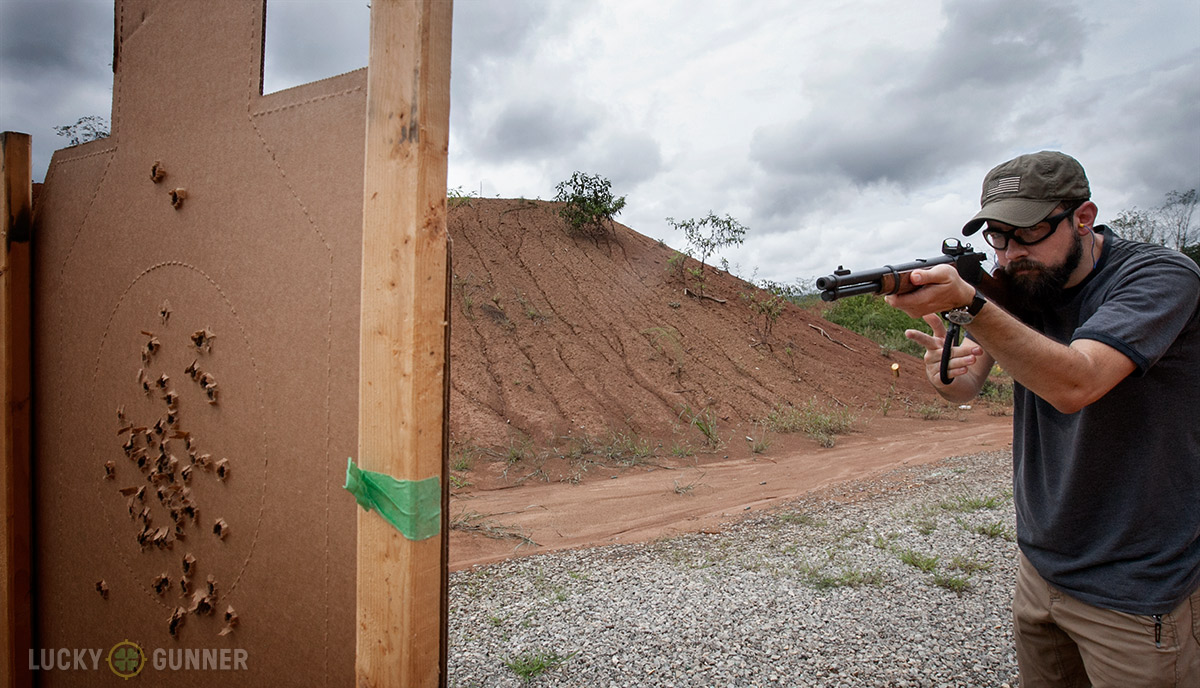
The heavier recoil of the .30-30 meant that it wasn’t as fast as the .357, but I didn’t have any problems with the action binding. I’m not sure if this is due to how the Winchester action works, or if it has more to do with how I was operating it. In either case, I would still recommend snap caps and lots of dry fire practice for familiarity with the gun’s operation.
For a .30 caliber centerfire rifle, the .30-30 cartridge has relatively mild recoil, but inexperienced shooters may take some time getting used to it, especially if they make the painful rookie mistake of incorrect stock placement on the shoulder. If you have the opportunity to coach someone in learning to rapid fire the .30-30, be sure to help them with stock placement first thing so they don’t develop a flinch early on.
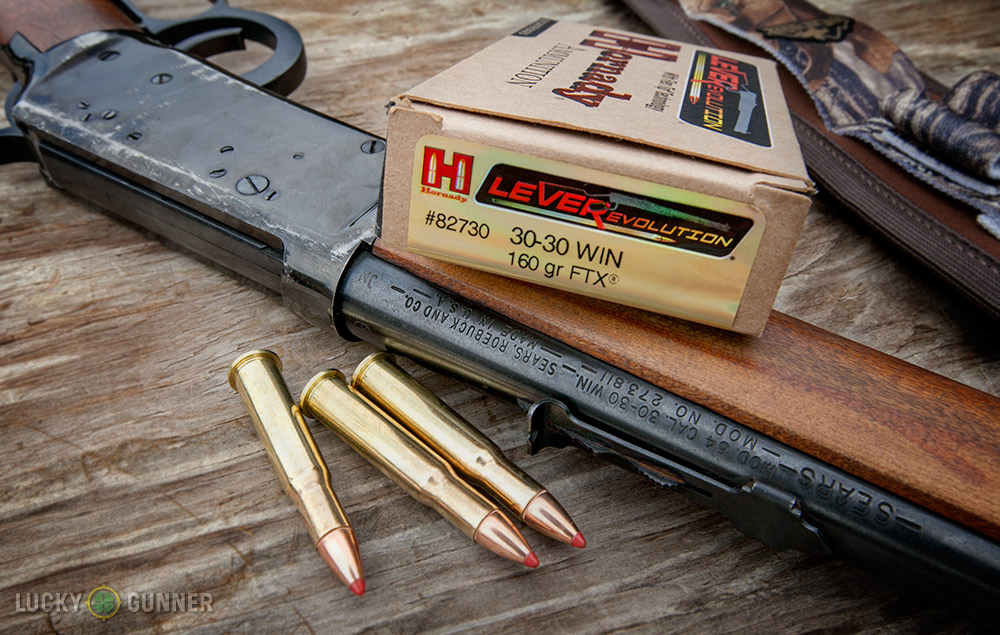
Overall, I found both rifles easy to shoot and manipulate on targets at close range, aided by their light weight and slim profiles. Even the homely, neglected little Sears rifle ran like a champ — the well-used action worked very smoothly, and it didn’t take long to work up speed and cut down time between shots.
Lever Action Mods and Accessories on a Budget
I may have tricked out my own 1894 with all kind of anachronistic modifications that will make the purists cringe, but most lever actions don’t really need much done to them in order to make them suitable for home-defense. However, there’s room for improvement even if money is tight. In order of priority, here are a few things I would suggest for the budget-minded lever-action owner.
Snap Caps: The big potential downfall of using the lever action under stress is fumbling with the action. With snap cap dummy rounds, you can practice loading the mag tube, working the action, and ejecting rounds. Simply operating the gun dry isn’t good enough in this case because any mistakes you make that could cause feeding problems won’t show up until it’s run with ammo or dummy rounds.
Flashlight and Mount: Look through the archives of the Lounge and you’ll find that I’m a strong believer in white lights on self-defense guns. Lights are not only a critical for helping your aim, but they’re also necessary in order to identify your target at night to avoid unnecessary tragedies.
With handguns, you can always hold a flashlight in your off-hand, but unfortunately that’s not possible for rifles, so the lights have to be mounted directly to the guns. Options for mounting a light on lever actions are rather limited. If you happen to have a Marlin, Wild West Guns has a light mount that attaches to the magazine tube. There are other aftermarket mounting options like the Stick N Shoot magnet light, but unfortunately many of these accessories won’t be attractive to the budget-minded. It may not be elegant, but one possible solution might be to screw a small length of picatinny rail into the wooden forestock and attach a normal flashlight rail mount to that. Others have had success with home brew solutions involving zip ties, or even duct tape. Whatever mounting option is chosen, it should be tested with live fire to make sure recoil won’t send the flashlight flying toward the target.
Sling and Sling Mount: While not as vital as a white light, a sling on a home defense rifle allows the user to keep the gun handy while performing other tasks. This can be especially vital for those with small children or anyone else who might be physically dependent on your help. Many lever actions don’t come equipped with sling mounts, but inexpensive solutions are available. Rear studs screw directly into the buttstock and a front stud can either be attached to the foreend or to the magazine tube.
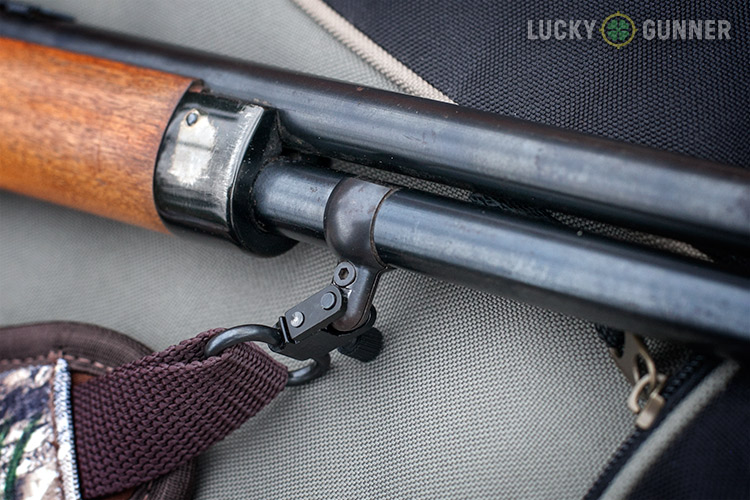
Ammo Carrier: As I’ve mentioned, lever actions usually have fairly low ammo capacity. It’s not a bad idea to invest in an inexpensive nylon buttstock sleeve with ammo loops to keep a few extra rounds on hand. Be warned that reloading the magazine tube is not easy to do quickly, especially under pressure — one more reason to practice with snap caps!
Improved Sights: The open sights that come on most lever actions might be quick in broad daylight, but aren’t good for much in the dark. For someone on a tight budget, I’d suggest they spent their money on practice ammo before sinking a lot of cash into sights, but if there’s any money left over, night sights can go a long way. Even a non-illuminated ghost ring rear sight might be easier to use in low light, especially if used with a fiber optic front sight. If nothing else, a little white paint on the front sight blade is an improvement over a black sight that disappears as soon as the lights go out.
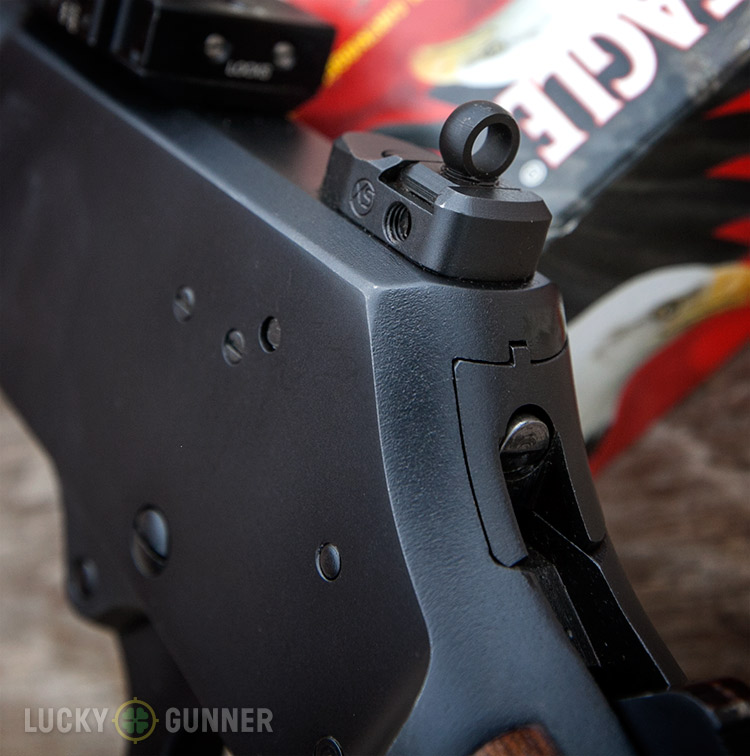
Paracord Wrap: It doesn’t take many repetitions of rapidly working the lever before the back of the fingers on your firing hand will start to feel a little raw. One final cheap improvement that can be made to any lever action is a paracord wrap to pad your fingers when pushing against the lever. Leather, or even an old shoestring can also work and there are plenty of tutorials online to show you how to wrap the lever without interfering with its operation.
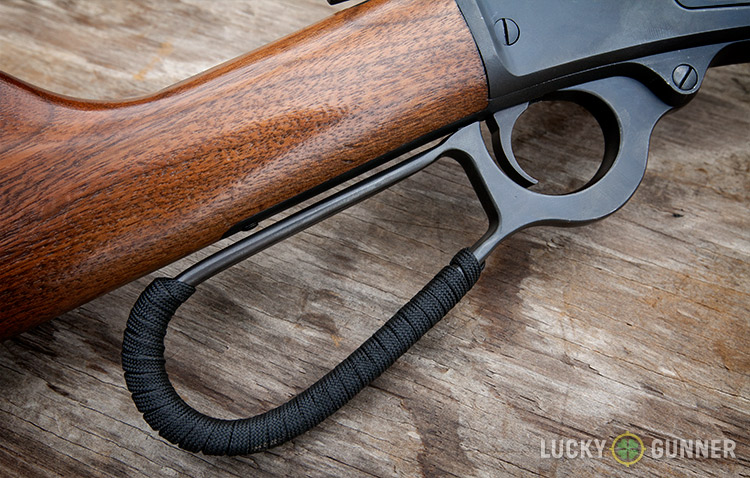
An Imperfect Solution
A lever action wouldn’t be my first choice for home defense, but if that’s what someone has, and they can’t afford or aren’t inclined to upgrade, then it certainly works. Practice is vital to develop the right muscle memory for operating the action correctly. Ammunition for most centerfire lever action calibers is pricey, making regular practice difficult on a budget. Fortunately, much of the repetition required for familiarization with the rifle can be done at home with dummy rounds.
For many people, I think a lever action rifle might even be a better choice than a pump action shotgun, except for those who have extensive experience with the latter. Although they’re frequently recommended for home-defense, the 12 gauge pump action shotgun has the same potential problem of short stroking the action, and also has more punishing recoil, which means slower follow-up shots.
On the other end of the spectrum, if given the choice, I would personally take almost any centerfire lever action for home defense over a .380 pocket pistol or snub nose revolver. They are far from ideal compared to the other options we have available today, but the humble lever-action has been defending homes for well over a century and a half, and it shouldn’t be overlooked.
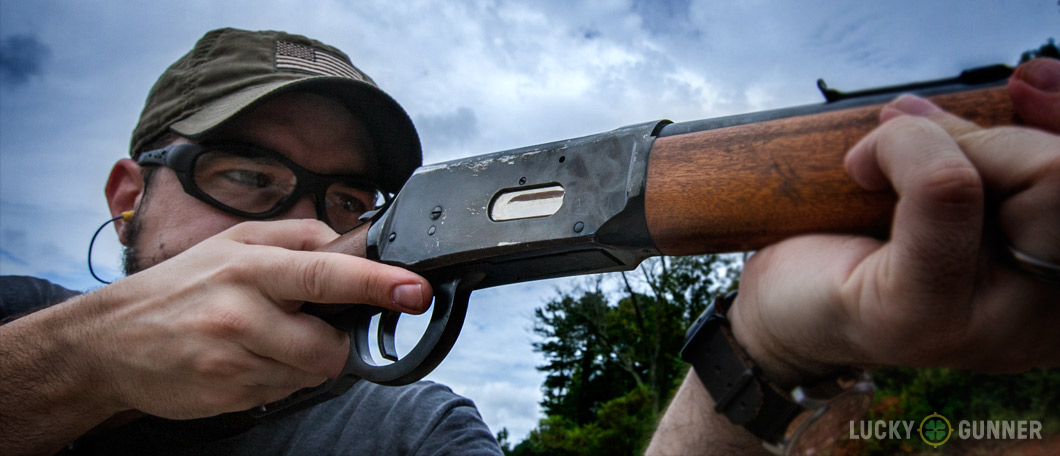

I have 2 of the 30-30 in lever action–one is the Winchester which I have used for deer hunting for years and a Marlin which has rarely been shot–both guns are great rifles and have served me well, I choose to used the Winchester and not the Marlin because the stck is slimmer for packing and a little lighter but after firing several rounds I think the Marlin overall is more accurate but both are really good at 100 yds–good article.
I have 2 of the 30-30 in lever action–one is the Winchester which I have used for deer hunting for years and a Marlin which has rarely been shot–both guns are great rifles and have served me well, I choose to used the Winchester and not the Marlin because the stck is slimmer for packing and a little lighter but after firing several rounds I think the Marlin overall is more accurate but both are really good at 100 yds–good article.
Go Wykons … if there is any.
I hated my marlin in .357… way too clunky. My Winchester is as smooth as glass with .357 or .38 and it weighs less.
I also own a Sears lever action in 30-30. After some time on the bench and in the Dura-coat booth it runs and looks beautiful. As the Author said, not my first choice if I hear a bump in the night but it will definitely put a perp on the ground in a hurry.
I hated my marlin in .357… way too clunky. My Winchester is as smooth as glass with .357 or .38 and it weighs less.
Lever action rifle worked for Chuck Connors for years.
I also own a Sears lever action in 30-30. After some time on the bench and in the Dura-coat booth it runs and looks beautiful. As the Author said, not my first choice if I hear a bump in the night but it will definitely put a perp on the ground in a hurry.
Lever action rifle worked for Chuck Connors for years.
Yeah, and did you see the babe he got to ‘marry’ when he was Geronimo. Dawg!
I have grown to love my Marlin 1894c. Want see them tactical look at Grizzy Customs. They do custom stuff including rail systems and action job.
I owned the Marlin in .357 and carried it along on-duty for several years when we carried SW revolvers in .357. I later used it for predator calling and trap-line runs. A gunsmith can smooth out the burrs in the Marlin and practice makes it quite a useable piece to at least 100 yards with the open sights.
I have grown to love my Marlin 1894c. Want see them tactical look at Grizzy Customs. They do custom stuff including rail systems and action job.
I owned the Marlin in .357 and carried it along on-duty for several years when we carried SW revolvers in .357. I later used it for predator calling and trap-line runs. A gunsmith can smooth out the burrs in the Marlin and practice makes it quite a useable piece to at least 100 yards with the open sights.
My Marlin 1894C might feel like a peashooter, but I definitely wouldn't want to be standing at its business end.
Like Chris states: if that's all you got, make it work!
Greetings from a gun enthusiast in Germany
My Marlin 1894C might feel like a peashooter, but I definitely wouldn’t want to be standing at its business end.
Like Chris states: if that’s all you got, make it work!
Greetings from a gun enthusiast in Germany
Great article!
Great article!
Got a couple of Marlin 30-30 including a youth model which is a great size. Also got one in 35 but that would be I bit much inside your house.
Got a couple of Marlin 30-30 including a youth model which is a great size. Also got one in 35 but that would be I bit much inside your house.
The Marlin Model 1894 in .357 is one heck of a rifle. I've had one for several years and love it. It's stock with iron sights but is very accurate. I use it for Deer hunting in MN when I go Deer hunting. Out to about 75 yards it's about as good as a 30-30. Where I used to hunt you didn't have much longer shots than that anyway.
have a winchester 94 bought at las duty station Ft. polk la. 1978
Seriously….did I miss something or did you completely ignore Henry rifles….They ARE all American and T-HE-Y A-R-E- A-W-E-S-O-M-E and gorgeous….Here….Hold my target….I'll show you what they can do….. ; )
The Marlin Model 1894 in .357 is one heck of a rifle. I’ve had one for several years and love it. It’s stock with iron sights but is very accurate. I use it for Deer hunting in MN when I go Deer hunting. Out to about 75 yards it’s about as good as a 30-30. Where I used to hunt you didn’t have much longer shots than that anyway.
Down in the swamp, eh? My brother thought that a .12 ga. 00 buckshot would be a good choice down there, but, my trophy (taken with my Win.94 in 30-30) is on the wall, his probably died somewhere, but not where we could find it. Now he takes his .357 pair – the max. shot will be under 50 yards in ‘our’ swamp.
have a winchester 94 bought at las duty station Ft. polk la. 1978
Seriously….did I miss something or did you completely ignore Henry rifles….They ARE all American and T-HE-Y A-R-E- A-W-E-S-O-M-E and gorgeous….Here….Hold my target….I’ll show you what they can do….. ; )
Take another look at the article, he does indeed mention the Henry. He doesn’t say anything, but it is mentioned!
I would insist on a bullet port to keep the tube fed. I don’t like removing the feed rod to fill a gun while it is pointing up. Rossi makes some very accurate levers.
I’ve never had my hands on a Henry in anything but .22, but the one I shot was a real joy to operate. Easy, silky smooth action and accurate as all get out. I took the top off a soda bottle with one shot at about 20 yards (after my brother and uncle had each emptied the tube trying to hit it, I might add). The one I shot had the heavy octagon barrel, and that thing was pin-point accurate.
One of these days when I get my cowboy set it’ll probably be a Henry Big Boy .357 or .45 LC.
Take another look at the article, he does indeed mention the Henry. He doesn't say anything, but it is mentioned!
FMG pub. had an article on strapping a flashlight to a 12 gauge sxs coach gun with tie-wraps. It works like a charm. My little Baikal now has a flash light when needed for "social control" in the dark.
FMG pub. had an article on strapping a flashlight to a 12 gauge sxs coach gun with tie-wraps. It works like a charm. My little Baikal now has a flash light when needed for “social control” in the dark.
I keep a "real" .30-30 Winchester 94 Trapper in the armoire, just in case! With the 16" barrel it's perfect in close quarters! Makes a good pig gun in the brush too! But, as the author says, practice in full-stroking the lever is crucial in the event of an emergency!
I keep a “real” .30-30 Winchester 94 Trapper in the armoire, just in case! With the 16″ barrel it’s perfect in close quarters! Makes a good pig gun in the brush too! But, as the author says, practice in full-stroking the lever is crucial in the event of an emergency!
The point of the article was to address the needs of the Budget constrained folks with those (Common ) hand me down 30-30's which are most likely to be a Winchester or a Marlin. Nevertheless he did mention Henry along with a few others.
The military's 30 carbine, throws a 110 bullet at 2000fps.
A 300 "Blackout" throws a 125gr bullet at 2250fps
The Russian 7.62X39 throws a 123gr at 2330fps
A 30-30 throws a 170 bullet at 2200fps. and a 150 at 2390.
Been defending the homestead since 1895.
just layed away a rossi 357 lever action with a 16 in barrel. and have my eye on a marlin 3030
just layed away a rossi 357 lever action with a 16 in barrel. and have my eye on a marlin 3030
hope yours worked out better than mine did. that thing had feed issues that sometimes required disassembling of the rifle to clear. I kid you not that thing could mangle it’s feed ammo in new and interesting ways. I hated that rossi taurus junk. Still have a 357 Taurus revolver – nice accurate gun but after about 50 rounds the casings wont drop out of the cylinder and stick in there like they are glued into the thing. AFAIK Brazilians should stick to building big statues of Jesus on mountain tops and stop trying to make firearms.
Very informative. Good idea’s. Good job well done
The 30 30 is a good all around SHTF rifle. There’s a lot of ammo out there very reliable ect. The new Hornady’s Lever Evolution ammo adds a little bit more range to it. It may not be the first gun or rifle I grab. But I will never part with it either. And sure enough I would hate to be on the wrong end of it.
My dad’s old (mid-70’s I think) Marlin .30-30 was the first rifle bigger than a .22 I ever shot. I’ve taken more deer with that gun than with a shotgun, black powder, bow, or my .270 combined. And I know first hand they can cycle very quickly when done right. I had a 7 point come down a trail right next to my tree stand years ago at a full out run. I stood up in my stand and put three round right through the kill zone with him on the move. He kept running to the end of the field, then dropped.
They’re not as flashy as an AR or a bull-pup semi auto, but I love lever actions. Solid, reliable, and really fun to shoot.
The first real gun(non-air) I fired was a marlin 30as 30/30 when I was 8. I then purchased it from my friend for $100 when I was 12. It got him around 20 whitetail in that time, and myself a handful more over the past 25yrs since. Although I primarily use AK pattern rifles now days, it balances, points and shoots phenomenally, and will always be held in high regard.
The only problem with levers is that every time you need to get in and out of a vehicle you need unload in my state. So if you do drives on multiple parcels detachable mags are way more convenient. Constant loading and reloading can cause oal issues from rnd to rnd, and thus deminished accuracy.
However, for home defense tube feeds make sense. They allow for topping off the mag whenever convenient, say while moving room to room, cover to cover. Besides side saddle, ammo can be in a bandoleer sling. Vertical mags need to be out, and require 2 hands for loading. If the scenario is no budget, extra mags might not be there, and it probably won’t be shot much. Leaving a semiauto loaded a long time decreases reliability, plus many people just don’t want their guns kept loaded.
A 16″-20″ lever in .38 sp is plenty powerful and mild in muzzle signature. It will be easier to put rounds on target faster with more precision than a handgun.
A pump shotgun can do all that with more versatility and effectiveness, but with increased costs of ammo and recoil. If someone has a choice or a $200 budget I’d recommend a 12 ga shotgun for the sheer squirrel to bear versatility.
I myself induce more malfunctions regularly with pumps, and have never had an issue cycling a lever(a bad case of “the left hand not knowing what the right is doing”). A lever places your finger on the trigger only upon closing. Without that trigger disconnect, the pump gets me in trouble short cycling, requiring the slide release and recharging it.
I’ve racked hundreds of rounds of all types through my cheaper than dirt walmart Maverick (cheap Mossberg knockoff think it cost like $160 years ago) 12GA without a single jam or feed malfunction ever so I’m not sure what induced malfunctions means. Is that like when you try to work the feed action upside down or with the eject chute facing straight up or something I’ve never tried those but assume it’s maybe a problematic thing to do?
Now my lever gun was a Brazilian made Taurus brand and that thing had feed jams pretty much every other tube full would hang up on one round in the tube. Tried every type of ammo I could find from flat nosed wad cutter magnums to 38 specials HP, round nose you name it they all jammed about 10% of the time trying to feed. Finally sold the thing to a gunsmith who felt he could get the kinks worked out. Piece of junk put me off levers possibly forever.
As a former hunter safety instructor I don’t like the tube magazine. Up here in Canada we leave our guns unloaded with the ammunition stored in a locked cabinet. For home defence or dismounting from a vehicle a clip is far quicker to load, with no wear on the tips of the cartridges.
It’s hard to be sure all of the cartridges are out of a tube magazine when unloading. Leaving a 30:30 with its rudimentary cocking mechanism loaded in the home is just asking for tragedy.
My Remington 870 shotgun also has a tube magazine, but it’s easier to tell at a glance or a touch that it’s empty.
My grandfather’s rifle was a 38-55, badly shot out. He was notorious for bad marksmanship, yet he consistently killed the deer for the camp. Once, the story goes, he brought down a buck on his 14th shot, having reloaded a couple of times. The deer had a long way to go, and his friend Frank said that “It sounded like Charlie had three in the air and two in the barrel when he was shooting at that buck.”
He was the only man in the hunting camps around Calibogie who had to go to town for more shells before the week was over.
I would never consider anything that jams in the way lever-guns jam as a home defense option. The problem isn’t that they jam more (although they may in fact) but with the types of jams that occur. I’ve had jams in lever guns that requires tools and 10 minutes to get cleared. It’s just the nature of the design to every so often come up with new kinds of jams never before imagined.
Regular semi-auto feeds can jam too (it’s pretty rare but happens) but I always try to just manually feed the next round (two seconds at most) if that doesn’t get it roll/tilt it over to allow the ejection slot to face down and manually feed the next round (two more seconds) and if that still doesn’t get it roll if the other way and peek in the feed eject window and 9 times out of 10 it’s just OH hey look is a casing flipped over inside all cockeyed or something again usually another 5-10 seconds to get it cleared and you’re back in business.
So summary – I’ve never had a downtime type feed jam failure on any of my semi’s. But yeah buddy I’ve had more than one feed jam in my lever gun that was to the point where I’m just about disassembling the thing to get it back online
Agreed the lever action rifle is good if that’s all you have, but one thing he didn’t address is with a round like 30-30,44,357 what’s going to happen if you miss. Sheet rock won’t stop any of these rounds giving chance to accidents none of us want. Sell your trusty old lever action and buy a shot gun. Bird shot will do a number on an intruder and if you feel you need more make round 4&5 00 buckshot.
Exactly how many rifle caliber rounds does the author think it takes for self defense? They’re ‘outclassed’ by mag fed autos? Where the hell does he think he will be home defending, Baghdad? Does he have a lot of friends who ‘short stroke’ their 12 gauge? Never seen it myself.